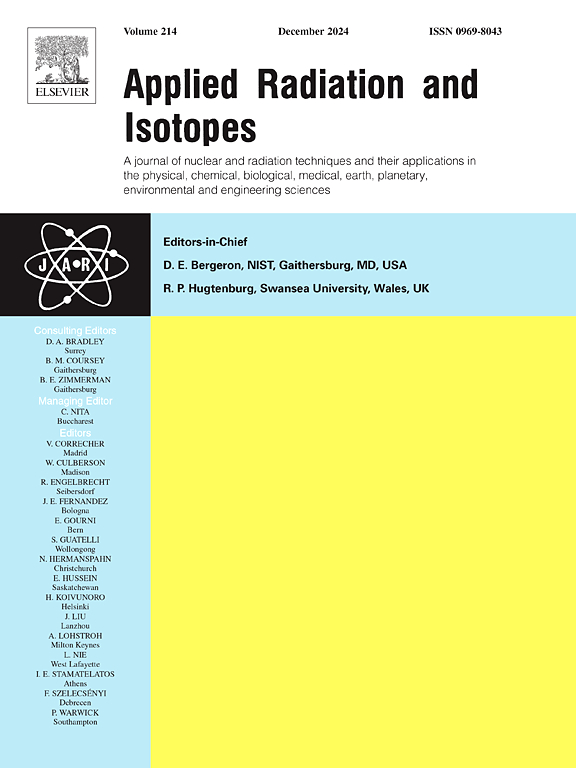On-site activity determination of 211At using absolute 4pi-alpha liquid scintillation counting and HPGe
IF 1.6
3区 工程技术
Q3 CHEMISTRY, INORGANIC & NUCLEAR
引用次数: 0
Abstract
For accurate activity measurements and to comply with EU regulations traceability is required. For alpha emitters of interest for emerging targeted alpha therapies (TAT), like 211At, standardised samples are not readily available. The use of gamma spectrometry can come with high uncertainties due to its reliance on decay data for gamma emissions. A new method for determining the activity of 211At in a clinical setting is proposed, i.e. on-site measurement, using absolute 4pi-alpha liquid scintillation counting (LSC) with thresholding on a portable TDCR counter. The method focuses on measuring only the alpha particles and not the electrons, which emission intensities come with a higher uncertainty. Using the absolute LSC method the relative expanded measurement uncertainty was 2.2 % (k = 2). A comparison using gamma spectrometry and the more readily available high purity germanium (HPGe) detector, the relative expanded uncertainty was 12 % (k = 2). The largest contribution to the much higher uncertainty of the gamma spectrometry comes from the uncertainties in the decay data. Using a portable TDCR-detector is a viable approach to establishing traceability for 211At, where transportation to a national metrology lab is not feasible. With better decay data the uncertainty of the gamma spectrometry can be reduced by at least one third, which would make it a better alternative when absolute measurements are not available.
求助全文
约1分钟内获得全文
求助全文
来源期刊

Applied Radiation and Isotopes
工程技术-核科学技术
CiteScore
3.00
自引率
12.50%
发文量
406
审稿时长
13.5 months
期刊介绍:
Applied Radiation and Isotopes provides a high quality medium for the publication of substantial, original and scientific and technological papers on the development and peaceful application of nuclear, radiation and radionuclide techniques in chemistry, physics, biochemistry, biology, medicine, security, engineering and in the earth, planetary and environmental sciences, all including dosimetry. Nuclear techniques are defined in the broadest sense and both experimental and theoretical papers are welcome. They include the development and use of α- and β-particles, X-rays and γ-rays, neutrons and other nuclear particles and radiations from all sources, including radionuclides, synchrotron sources, cyclotrons and reactors and from the natural environment.
The journal aims to publish papers with significance to an international audience, containing substantial novelty and scientific impact. The Editors reserve the rights to reject, with or without external review, papers that do not meet these criteria.
Papers dealing with radiation processing, i.e., where radiation is used to bring about a biological, chemical or physical change in a material, should be directed to our sister journal Radiation Physics and Chemistry.
 求助内容:
求助内容: 应助结果提醒方式:
应助结果提醒方式:


